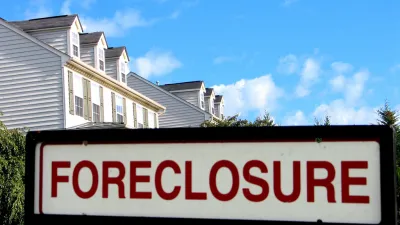Contracts for deed are gaining popularity at investment firms that scooped up swaths of foreclosed properties during the Great Recession. The risk for buyers, however, smacks of the same misdeeds that created that historic crisis in the first place.

The editorial Board of The New York Times raises alarms about the growing prominence of contracts for deed—a Depression-era financial arrangement with roots in racist housing policy.
The editorial follows a recent report in The Times by Alexandra Stevenson and Matthew Goldstein, finding contracts for deed "increasingly being used by investment firms that have bought thousands of foreclosed homes and want to sell them to lower-income buyers 'as is,'" according to the editorial.
Contracts for deed make gouging possible, because unlike traditional mortgages, there is no appraisal or inspection to ensure that the loan amount is reasonable. They also let an investor swiftly evict buyers for missed payments, rather than giving them time to catch up, as required under a mortgage. And they usually require the buyer to pay hefty upfront fees. Unlike a rental security deposit, however, the fee is almost never refundable.
The editorial compares contracts for deed to the subprime loans of the housing bubble leading up to the Great Recession. After making it clear that contracts for deed only help investors, while "nearly always" inflicting harm for borrowers, the editorial calls for the Consumer Financial Protection Bureau to "assert its authority over these contracts…"
FULL STORY: The Racist Roots of a Way to Sell Homes

National Parks Layoffs Will Cause Communities to Lose Billions
Thousands of essential park workers were laid off this week, just before the busy spring break season.

Retro-silient?: America’s First “Eco-burb,” The Woodlands Turns 50
A master-planned community north of Houston offers lessons on green infrastructure and resilient design, but falls short of its founder’s lofty affordability and walkability goals.

Delivering for America Plan Will Downgrade Mail Service in at Least 49.5 Percent of Zip Codes
Republican and Democrat lawmakers criticize the plan for its disproportionate negative impact on rural communities.

Test News Post 1
This is a summary

Test News Headline 46
Test for the image on the front page.

Balancing Bombs and Butterflies: How the National Guard Protects a Rare Species
The National Guard at Fort Indiantown Gap uses GIS technology and land management strategies to balance military training with conservation efforts, ensuring the survival of the rare eastern regal fritillary butterfly.
Urban Design for Planners 1: Software Tools
This six-course series explores essential urban design concepts using open source software and equips planners with the tools they need to participate fully in the urban design process.
Planning for Universal Design
Learn the tools for implementing Universal Design in planning regulations.
EMC Planning Group, Inc.
Planetizen
Planetizen
Mpact (formerly Rail~Volution)
Great Falls Development Authority, Inc.
HUDs Office of Policy Development and Research
NYU Wagner Graduate School of Public Service





























